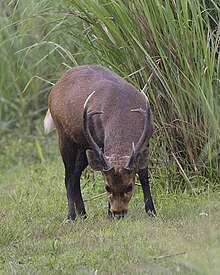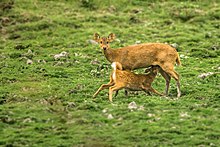| Indian hog deer | |
|---|---|

| |
| Conservation status | |
 Endangered (IUCN 3.1) | |
| Scientific classification | |
| Domain: | Eukaryota |
| Kingdom: | Animalia |
| Phylum: | Chordata |
| Class: | Mammalia |
| Order: | Artiodactyla |
| Family: | Cervidae |
| Genus: | Axis |
| Species: | A. porcinus |
| Binomial name | |
| Axis porcinus (Zimmermann, 1780) | |

| |
| Range in green | |
| Synonyms | |
|
Hyelaphus porcinus (Zimmermann, 1780) | |
The Indian hog deer (Axis porcinus), or Indochinese hog deer, is a small cervid native to the region of the Indian subcontinent and Indo-Gangetic Plain. Introduced populations are established in Australia, as well as the United States and Sri Lanka.
Its name derives from the hog-like manner in which it runs through forests (with its head hung low), to ease ducking under obstacles instead of leaping over them, like most other deer.
Taxonomy
Cervus porcinus was the scientific name used by Eberhard August Wilhelm von Zimmermann in 1777 and 1780, based on an earlier description of Indian hog deer brought to England from India. It was placed in the genus Axis by William Jardine in 1835 and by Brian Houghton Hodgson in 1847. In 2004, it was proposed to be placed in the genus Hyelaphus. The proposal has not been accepted, with most authors keeping it under Axis. A subspecies, A. p. annamiticus, was once considered its own species, but is now generally considered the same species as A. porcinus.
Description
| This section needs additional citations for verification. Please help improve this article by adding citations to reliable sources in this section. Unsourced material may be challenged and removed. (January 2022) (Learn how and when to remove this message) |
A mature hog deer stag stands about 70 centimetres (28 in) at the shoulder, and weighs approximately 50 kilograms (110 lb); hinds are much smaller, standing about 61 centimetres (24 in) and weighing around 30 kilograms (66 lb). They are very solidly built, with a long body and relatively short legs; the line of the back slopes upward from the shoulders to a high rump. The ears are rounded; older animals tend to become light coloured in the face and neck. The Indian hog deer's coat is quite thick, and generally a uniform dark-brown in winter, except for the underparts of the body and legs, which are lighter in colour. During late spring, the change to a summer coat of rich reddish-brown commences, although this may vary between individuals. Many hog deer show a dark dorsal stripe extending from the head down the back of the neck, and along the spine. In summer, there is usually a uniform row of light-coloured spots along either side of the dorsal stripe from the shoulders to the rump. The tail is fairly short and brown, but tipped with white. The underside of the tail is white, and the deer can fan the white hairs out in a distinctive alarm display.

Indian hog deer have preorbital glands on the face just below the eyes and metatarsal glands located high on the side of the rear legs. Pedal glands are located between the cleaves or toes of the hind hooves.
The antlers of a mature hog deer stag are typically three tined, having a brow tine and a solid main beam terminating in inner and outer top tines. However, antlers with more points are not uncommon. The distinctive features of typical hog deer antlers are the acute angle between the brow tine and main beam, and the fact that the inner tops tend to be short and angle back from the main beam and across towards the opposite antler.
Distribution and habitat
The Indian hog deer's status in Pakistan is uncertain; it occurs in northern India, Nepal, southern Bhutan, Bangladesh, Myanmar and China's Yunnan Province, has been reintroduced to Thailand but is locally extinct in Laos and Vietnam. A small, isolated population lives in Cambodia’s Prek Prasab Wildlife Sanctuary.
Behaviour and ecology
The Indian hog deer is gregarious only when conditions are favorable and do not form a "unit" at these times, fleeing in different directions rather than in a herd. When alarmed, it makes a whistling vocalization or a warning bark. Home ranges vary widely in size, but average about 0.70 km (0.27 sq mi). Males are aggressive, and may become territorial at low population densities, marking its territory with glandular secretions. During the rut, males gather in open meadows, pawing the ground during antagonistic encounters. Harems are not created, with males courting and defending a single female at any given time. Population densities may be as low as 0.1 animals per square kilometer in riverine valleys, rising to over 19 individuals per square kilometer in grassy flood plains.


The tiger, leopard and clouded leopard are known predators of the Indian hog deer. Other known predators include the Burmese python and dhole.
See also
References
- ^ Timmins, R.; Duckworth, J.W.; Samba Kumar, N.; Anwarul Islam, M.; Sagar Baral, H.; Long, B.; Maxwell, A. (2015). "Axis porcinus". IUCN Red List of Threatened Species. 2015: e.T41784A22157664. doi:10.2305/IUCN.UK.2015-4.RLTS.T41784A22157664.en. Retrieved 21 January 2022.
- Mayze, R.J. & Moore, G.I. (1990). The Hog Deer. Warragul, Victoria: Australian Deer Research Foundation. ISBN 9780959343861.
- Bentley, A. (1998). An Introduction to the Deer of Australia: With Special Reference to Victoria. Warragul, Victoria: Australian Deer Research Foundation. ISBN 9780958573214.
- Zimmermann, E.A.W. (1777). "Cornibus teretibus". Specimen zoologiae geographicae, quadrupedum domicilia et migrationes sistens. Leiden: Apud Theodorum Haak, et Socios. pp. 532–535.
- Zimmermann, E.A.W. (1780). "Der dickleibige Hirsch". Geographische Geschichte des Menschen, und der allgemein verbreiteten vierfüßigen Thiere. Vol. 2. Leipzig: Weygand. p. 131.
- Jardine, W. (1835). "The brown porcupine Axis Axis porcinus". The natural history of the ruminating animals. Edinburgh: Lizars. pp. 203–204.
- Hodgson, B.H. (1847). "On various genera of the ruminants". The Journal of the Asiatic Society of Bengal. 16 (2): 685–711.
- Meijaard, E. & Groves, C.P. (2004). "Morphometrical relationships between South-east Asian deer (Cervidae, tribe Cervini): evolutionary and biogeographic implications". Journal of Zoology. 263 (2): 179–196. doi:10.1017/S0952836904005011.
- Pitra, C.; Fickel, J.; Meijaard, E. & Groves, C.P. (2004). "Evolution and phylogeny of old world deer". Molecular Phylogenetics and Evolution. 33 (3): 880–895. Bibcode:2004MolPE..33..880P. doi:10.1016/j.ympev.2004.07.013. PMID 15522810.
- Groves, C.P. & Grubb, P. (2011). Ungulate taxonomy (PDF). Baltimore, Maryland: The Johns Hopkins University Press. Archived from the original (PDF) on 2021-10-30. Retrieved 2021-08-25.
- Gupta, S. K.; Kumar, A.; Angom, S.; Singh, B.; Ghazi, M. G. U.; Tuboi, C.; Hussain, S. A. (2018). "Genetic analysis of endangered hog deer (Axis porcinus) reveals two distinct lineages from the Indian subcontinent". Scientific Reports. 8 (1): 1–12. Bibcode:2018NatSR...816308G. doi:10.1038/s41598-018-34482-9. PMC 6218551. PMID 30397218.
- Michelin, Andrea. "Axis porcinus". Animal Diversity Web. Retrieved 12 July 2022.
- "Rare hog deer confirmed to thrives in Cambodia raising hope for conservation in Cambodia and the world". WWF Asia Pacific. 2022. Retrieved 8 May 2023.
- Grassman Jr., L. I.; Tewes, M. E.; Silvy, N. J. & Kreetiyutanont, K. (2005). "Ecology of three sympatric felids in a mixed evergreen forest in North-central Thailand". Journal of Mammalogy. 86 (1): 29–38. doi:10.1644/1545-1542(2005)086<0029:EOTSFI>2.0.CO;2.
- Hill, E.; Linacre, A.; Toop, S.; Murphy, N. & Strugnell, J. (2019). "Widespread hybridization in the introduced hog deer population of Victoria, Australia, and its implications for conservation". Ecology and Evolution. 9 (18): 10828–10842. Bibcode:2019EcoEv...910828H. doi:10.1002/ece3.5603. PMC 6787866. PMID 31624584.
External links
"Axis porcinus". ASM Mammal Diversity Database. 1.5. American Society of Mammalogists. Retrieved 25 August 2021.
| Taxon identifiers | |
|---|---|
| Axis porcinus |
|
| Cervus porcinus | |